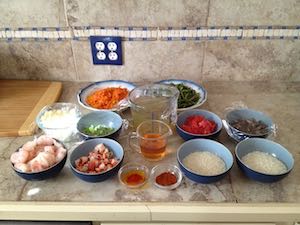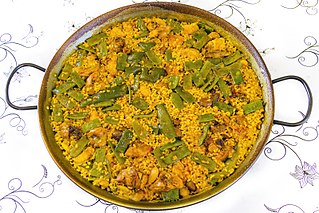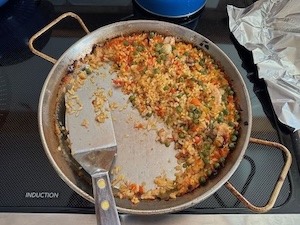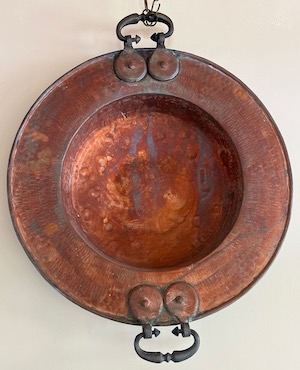Aug 31st, 2023 - Category: Miscellaneous
During this hot summer, we often opted for dishes that could be cooked outside on the grill. But how much meat and fish can be grilled before “food paralysis” sets in? You might know the feeling, it’s when a cheese plate and wine begin to feel like two of the major food groups. So I began to expand the grilling menu to a variety of grilled vegetables, squashes, and eventually to a dish that most people do not associate with grilling, Spanish Paella.
 Years ago, I used to make this regularly from a complex “traditional” recipe and it was a major production. It required over an hour of chopping followed by a careful orchestration of adding each ingredient at the right time. I blame this complexity on Alton Brown’s Paella episode of “Good Eats” where he explains the science behind the special rice used for this dish. However, more research uncovered the fact that paella was a dish that originated with farmers in Valencia Spain. It was made from inexpensive, readily available local ingredients such as tomatoes, onions, green beans, and rabbit. They would start with a mixture called the sofrito which roughly translates to “sautéed.” It’s an essential starting point and consists of sautéed tomatoes, onions, garlic and olive oil. Then the other ingredients were added: rosemary, sweet paprika, saffron, olive oil, and chicken broth. After making it this way several times, I ended up not enjoying the overpowering flavors of saffron and sweet paprika despite how numerous many recipes call these ingredients “essential.” Also, to me, a good low sodium fish or chicken (bone) broth with dry white wine added provides plenty of flavor, especially when quality fish or poultry is used.
Years ago, I used to make this regularly from a complex “traditional” recipe and it was a major production. It required over an hour of chopping followed by a careful orchestration of adding each ingredient at the right time. I blame this complexity on Alton Brown’s Paella episode of “Good Eats” where he explains the science behind the special rice used for this dish. However, more research uncovered the fact that paella was a dish that originated with farmers in Valencia Spain. It was made from inexpensive, readily available local ingredients such as tomatoes, onions, green beans, and rabbit. They would start with a mixture called the sofrito which roughly translates to “sautéed.” It’s an essential starting point and consists of sautéed tomatoes, onions, garlic and olive oil. Then the other ingredients were added: rosemary, sweet paprika, saffron, olive oil, and chicken broth. After making it this way several times, I ended up not enjoying the overpowering flavors of saffron and sweet paprika despite how numerous many recipes call these ingredients “essential.” Also, to me, a good low sodium fish or chicken (bone) broth with dry white wine added provides plenty of flavor, especially when quality fish or poultry is used.
 When I’m making a fish paella, I do go the extra mile and make the fish stock from scratch either from shrimp tails or from the bones of a fish that I have filleted. It does take planning ahead of time, but the results are well worth the effort. There are many recipes online but the basic ingredients I use are fresh thyme / parsley, whole peppercorns, a couple cloves of garlic, a bay leaf, a coarsely chopped celery stalk / carrot / onion, and a cup of dry white wine added to the two quarts of water. I sautée everything in butter starting with the onion and garlic first. Then I add the fish bones, water / white wine, boil for 45 minutes, strain, and you’re good to go.
When I’m making a fish paella, I do go the extra mile and make the fish stock from scratch either from shrimp tails or from the bones of a fish that I have filleted. It does take planning ahead of time, but the results are well worth the effort. There are many recipes online but the basic ingredients I use are fresh thyme / parsley, whole peppercorns, a couple cloves of garlic, a bay leaf, a coarsely chopped celery stalk / carrot / onion, and a cup of dry white wine added to the two quarts of water. I sautée everything in butter starting with the onion and garlic first. Then I add the fish bones, water / white wine, boil for 45 minutes, strain, and you’re good to go.
For the paella itself, I use onion, garlic, bell pepper, 3 medium tomatos, peas, 1 cup of paella rice, and 2 cups fish stock. There are options for the fish. I often use a “seafood medley” that can be purchased frozen at better grocery stores that includes shrimp, bay / sea scallops, mussels, and calamari. However clams, chunks of a firm white fish, and even lobster also work well. (Again, traditionally, a seafood paella includes mussels in the shell and tiger prawns with the heads and tails on, but this is paella without pain and I promise nobody will complain, especially after their first bite!) However, the rice is especially critical for paella and is one area where you only have a couple choices: either Arborio or “Paella rice” (Bomba). These short grain rices are the only ones that have a high absorption rate and stay firm during the long cooking times required. Arborio is the easiest to find at most grocery stores and it’s almost as good as the speciality paella rices. 
For the actual cooking, preheat the grill, put your paella pan on it (usually made out of thin carbon steel), and soften the onion and garlic in a generous amount of good olive oil. Then sautée the chopped bell pepper for a couple minutes, add the chopped tomatos, then add the rice. Once the rice is well coated with the sofrito mixture, add the pre-warmed fish stock. After this cooks for about 30 minutes on medium grill heat, add the peas and the fish, and cook for approximately another 15 minutes. It’s done when all the liquid is gone and the rice has begun to get a little crusty on the bottom. That crust, traditionally called Socarrat, is overrated in my opinion, but it IS delicious so you’re on your own when it comes to mastering the technique. I can tell you that it makes cleaning the paella pan quite a bit more challenging.
 Finally if you REALLY want to go traditional, fire up that backyard fire pit, pull out your antique 36” copper Paella pan, and go to town. I guarantee you will have enough paella to feed your entire neighborhood and still have leftovers. As for me, our old pan is hanging on a wall, where it’s going to stay!
Finally if you REALLY want to go traditional, fire up that backyard fire pit, pull out your antique 36” copper Paella pan, and go to town. I guarantee you will have enough paella to feed your entire neighborhood and still have leftovers. As for me, our old pan is hanging on a wall, where it’s going to stay!